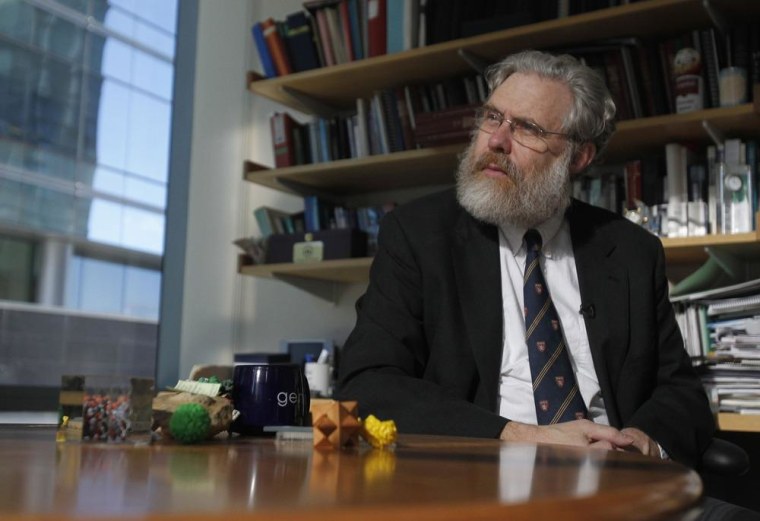COLUMBUS, Ohio — For years, scientists have been looking for ways to bring the long-extinct woolly mammoth back to life — and although the exercise sounds like a science-fiction movie plot of "Jurassic Park" proportions, there's progress to report.
The result almost certainly won't be a resurrection of the tusked behemoth exactly as it was thousands of years ago. It's more likely to be a genetically modified elephant that's adapted to the mammoth's traditionally chilly Pleistocene habitat.
"If we can make one, the second one will be easier," Harvard geneticist George Church, who's spearheading a project to engineer a cold-resistant elephant, told NBC News. Church discussed the de-extinction effort this week during the ScienceWriters2014 conference in Columbus.
Building a more mammoth-like elephant involves blending ancient mammoth DNA and modern-day elephant cells, but there are at least two approaches to the task: One research team has been trying to recover intact DNA from a 28,000-year-old mammoth carcass recovered from Siberian permafrost.
The remains appear to have been preserved well enough to retain liquid blood, but so far, the blood samples have been too degraded to provide useful genetic material, Russian scientists say. The team still hopes to find suitable samples.
Starting with the elephant
In contrast, Church and his colleagues are starting with the elephant rather than the mammoth: They're editing the elephant genome to insert the codes for traits associated with woolly mammoths, using a gene-splicing method known as CRISPR. Fifteen changes have been made so far, focusing on factors ranging from freeze-resistant hemoglobin to subcutaneous fat to sweat glands, Church said.
The researchers are being guided by the genetic sequence that was extracted in 2008 from woolly mammoth hairballs that were found frozen in Siberia. "We are not limited by it, but we are certainly inspired by it," Church said of the mammoth genome.
To test out those changes, the edited genetic code would be inserted into elephant stem cells, which would then be coaxed to grow into organoids, cellular structures that perform organ functions in the lab. Church said that placental cells and umbilical-cord cells harvested during the recent birth of a baby elephant in Tucson, Arizona, should serve his purpose nicely.
Church said it would take "a couple of years" to put the organoids through their test runs. Once the fully edited genome is ready to go, the mammoth-like traits would be inserted into an elephant egg cell for activation and implantation. Church suspects that an Asian elephant would be better-suited for the project, on the grounds that its genome is a closer match for mammoths.
Why do it?
To some, tweaking the elephant genome to produce creatures that are more like mammoths may sound like an adaptation of mad-scientist tales ranging from "Frankenstein" to "Jurassic Park." But Church and others argue that humans would have at least as much justification for restoring extinct species as they did for rendering them extinct in the first place. "De-extinction" is seen as a way to make up for what our ancestors did to such species as passenger pigeons, dodos and thylacines.
Another objection has to do with the idea of reviving a cold-tolerant species in a warming world. Is it really such a good idea to make elephants more like mammoths if the ancient permafrost is fading? Church maintains that mammoths might be just what the Siberian ecosystem needs. "Returning this keystone species to the tundras could stave off some effects of warming," he argued last year in a Scientific American essay.

In Church's view, experimenting with elephant genomes could eventually lead to hardier humans as well. In addition to the mammoth project, Church and his colleagues are using CRISPR gene-editing tools to see whether small genetic changes can produce outsized benefits. At the ScienceWriters2014 meeting, he noted that one change in particular has been linked to a "hundredfold" increase in resistance to viruses.
Last year, Church caused a stir with his suggestion that Neanderthal traits could be incorporated into the human genome. But he's now concentrating on somewhat less exotic genetic twists that could have an effect on the human aging process. "Merely reversing aging will, we think address age-related diseases," he said.
Don't expect to see the fast approach of immortality — or woolly mammoths, for that matter. Genetics may accelerate the pace of evolution, but the process still tends to take longer than expected. "Anyone who gets bored or easily frustrated, this is not the field for them," Church said.
Church's talk came during the 52nd annual New Horizons in Science briefing, which is part of ScienceWriters2014 and organized by the Council for the Advancement of Science Writing. NBC News science editor Alan Boyle is the current president of CASW.